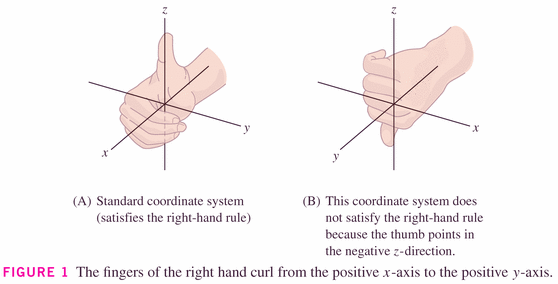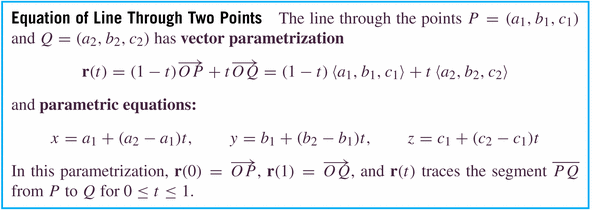- Homework 13.1 returned: Problems with
- linear combinations (e.g. #54, 56)
- Normalization (#45)
- Force problem, #59
- Homework 13.2 will be due next time (Thursday, 12/3).
- We'll have a quiz Thursday over 13.3 -- the dot product (although we'll start it today).
- Remember to look over the exam again, correcting your errors, and see me for 40% of your missed points back.
- Just a head's up: the final is Tuesday, 12/15. Would you have any interest in review session(s) prior to the final? If so, what days/times would be best?
- Read Section 13.4 for next Tuesday responding to the worksheet for section 13.4. There will be a quiz next Thursday over the reading.
- The right-hand rule

- Vocabulary:
- coordinate planes (p. 666)
- octants
- translates/translation (p. 669)
- parallel vectors
- equivalent vectors
- standard basis vectors
- Distance formula in R3:

examples:
- #1, p. 673
- #2, p. 673
- #14, p. 673
- Equations of Spheres and Cylinders
What are a sphere and a right cylinder?
- A sphere: all points equidistant from a given center.
- A right cylinder: all points equidistant from a given line.

examples: Draw the following:
- The set of points satisfying
- The set of points satisfying
One of the great things about mathematical software like Mathematica is that plotting these objects is easy.
- Parametric Equations of Lines:


- Additional examples:
- #27, p. 674
- #32, p. 674
- #51, p. 674
- Differentiating vector-valued functions is (may be!) much like
differentiating scalar functions.
Parametric equations of lines. Let's revisit uniform circular motion. As we saw in that case,
and
Now, let's "cut the string", and watch the ball fly. We had a formula for the trajectory, but now it's no longer in uniform circular motion. If there is no other force on the ball (e.g. we do this experiment in deep space), then it will fly off in a straight line. How can we represent this line parametrically?
Suppose that
, and that the string is cut at time
.
- Where's the ball, and in what direction will it travel?
- How can we represent this?

- We were looking at example #58, p. 665:
- First and foremost: Newton's laws of motion (in particular
), and statics.
- The parallelogram rule
- We can think of the force vectors on the cables as being composed of vector components (as well as coordinate components).
It turns out that we could see the solution very easily; calculating the force vectors was a little more complicated.
Now let's think a little more about how we resolve the vector forces into components: we'll find it convenient to define a product of two vectors as follows:

(how would you define this for vectors in two-space?). It's just component-wise multiplication, and we add up the results.
examples:
- #1, p. 680
- #6, p. 680
- #11, p. 681
It turns out that

where




Otherwise, the angle is acute. examples:
- #23, p. 681
- #60, p. 681
Finally then, we can put it all together to get this:

- First and foremost: Newton's laws of motion (in particular
- Additional examples:
- #53, 54, p. 681
- #70, p. 682